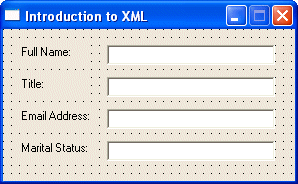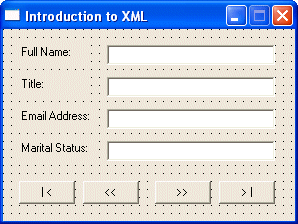|
Besides the data grid, you
can display the elements of an XML file in another other control of your
application, although some controls make it easier than others.
|
|
Text-based controls such as the Label and the TextBox
are equipped with a property called DataBindings. The DataBindings
property is a collection type which has other internal properties.
Therefore, you can use the Text field of the DataBindings property to
select the element that would be displayed in the control.
|
- Start Microsoft Visual C++ .Net or MS Visual Studio .Net and create
a new Windows Forms Application named IntroXML2 with its default
form
- To create an XML file, on the main menu, click Project -> Add New
Item...
- In the Templates list, click XML File (.xml)
- In the Name box, replace the string with employees

- Click Open
- Complete the file as follows:
<?xml version="1.0" encoding="utf-8"?>
<fullrecord>
<employee>
<fullname>Sylvie Aronson</fullname>
<title>Accountant</title>
<emailaddress>aronsons@bastia.edu</emailaddress>
<maritalstatus>Married</maritalstatus>
</employee>
<employee>
<fullname>Bertrand Yamaguchi</fullname>
<title>Junior Programmer</title>
<emailaddress>yamob1250@yahoo.com</emailaddress>
<maritalstatus>Married</maritalstatus>
<employee>
</employee>
<fullname>Anselme Bean</fullname>
<title>Sales Representative</title>
<emailaddress>binama@hotmail.com</emailaddress>
<maritalstatus>Widow</maritalstatus>
</employee>
<employee>
<fullname>Mauricette Thomas</fullname>
<title>Communications Director</title>
<emailaddress>youngintern@netscape.net</emailaddress>
<maritalstatus>Divorced</maritalstatus>
</employee>
<employee>
<fullname>Hermine Gray</fullname>
<title>Sales Representative</title>
<emailaddress>graynotdavis@emailcity.net</emailaddress>
<maritalstatus>Single</maritalstatus>
</employee>
</fullrecord>
|
- Display the form and design it as follows:
 |
| Control |
Name |
Text |
| Label |
|
Full Name: |
| TextBox |
txtFullName |
|
| Label |
|
Title |
| TextBox |
txtTitleName |
|
| Label |
|
Email Address: |
| TextBox |
txtEmailAddress |
|
| Label |
|
Marital Status: |
| TextBox |
txtMaritalStatus |
|
|
- Using the same approach we followed for the grid, double-click an
empty area of the form and change the file as follows:
#pragma once
namespace IntroXML2
{
using namespace System;
using namespace System::ComponentModel;
using namespace System::Collections;
using namespace System::Windows::Forms;
using namespace System::Data;
using namespace System::Drawing;
/// <summary>
/// Summary for Form1
///
/// WARNING: If you change the name of this class, you will need to change the
/// 'Resource File Name' property for the managed resource compiler tool
/// associated with all .resx files this class depends on. Otherwise,
/// the designers will not be able to interact properly with localized
/// resources associated with this form.
/// </summary>
public __gc class Form1 : public System::Windows::Forms::Form
{
public:
Form1(void)
{
InitializeComponent();
}
protected:
void Dispose(Boolean disposing)
{
if (disposing && components)
{
components->Dispose();
}
__super::Dispose(disposing);
}
private: System::Windows::Forms::Label * label1;
private: System::Windows::Forms::Label * label2;
private: System::Windows::Forms::Label * label3;
private: System::Windows::Forms::Label * label4;
private: System::Windows::Forms::TextBox * txtFullName;
private: System::Windows::Forms::TextBox * txtTitle;
private: System::Windows::Forms::TextBox * txtMaritalStatus;
private: System::Windows::Forms::TextBox * txtEmailAddress;
private:
/// <summary>
/// Required designer variable.
/// </summary>
System::ComponentModel::Container * components;
DataSet __gc *dsEmployees;
/// <summary>
/// Required method for Designer support - do not modify
/// the contents of this method with the code editor.
/// </summary>
void InitializeComponent(void)
{
. . .
}
private: System::Void Form1_Load(System::Object * sender, System::EventArgs * e)
{
dsEmployees = __gc new DataSet("employees");
dsEmployees->ReadXml(S"employees.xml");
this->txtFullName->DataBindings->Add(
new System::Windows::Forms::Binding(S"Text", this->dsEmployees, S"employee.fullname"));
this->txtTitle->DataBindings->Add(
new System::Windows::Forms::Binding(S"Text", this->dsEmployees, S"employee.title"));
this->txtEmailAddress->DataBindings->Add(
new System::Windows::Forms::Binding(S"Text", this->dsEmployees, S"employee.emailaddress"));
this->txtMaritalStatus->DataBindings->Add(
new System::Windows::Forms::Binding(S"Text", this->dsEmployees, S"employee.maritalstatus"));
}
};
}
|
- Test the application and notice that it displays the values of only
the first record
- Close the form and return to MSVC
- If you want to navigate through records, add four buttons named
txtFirstRecord, txtPreviousRecord, txtNextRecord, and txtLastRecord

- Double-click each of the navigation buttons and implement them as follows:
private: System::Void btnFirstRecord_Click(System::Object * sender, System::EventArgs * e)
{
this->BindingContext->get_Item(this->dsEmployees, S"employee")->Position = 0;
}
private: System::Void btnPreviousRecord_Click(System::Object * sender, System::EventArgs * e)
{
this->BindingContext->get_Item(this->dsEmployees, S"employee")->Position =
this->BindingContext->get_Item(this->dsEmployees, S"employee")->Position - 1;
}
private: System::Void btnNextRecord_Click(System::Object * sender, System::EventArgs * e)
{
this->BindingContext->get_Item(this->dsEmployees, S"employee")->Position =
this->BindingContext->get_Item(this->dsEmployees, S"employee")->Position + 1;
}
private: System::Void btnLastRecord_Click(System::Object * sender, System::EventArgs * e)
{
this->BindingContext->get_Item(this->dsEmployees, S"employee")->Position =
this->BindingContext->get_Item(this->dsEmployees, S"employee")->Count - 1;
}
|
- Test the application
|
|